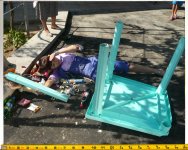gdi
Veteran
A very timid subject captured with the M8 in low light at f/4. On the Mamiya 65mm lens, very little DOF would have been conveyed at f/4, and in fact this is not the "sweet spot" of the lens. On the M8 with a ZM 35/2 Biogon however, f/4 gives plenty of depth and the lens is uber crisp at this aperture. So with the M8 I think "flexibility", with the M7 I think "extreme quality" in a compact package albeit suited to a narrower range of conditions required for optimal usage. For 4x5, what a PITA, so this is reserved for subjects requiring the utmost detail with the intent of eventual enlargement to 20 x 24 (minimum) and beyond. Again, this applies to the landscape genre.
That is a nice shot! 🙂
But it does look a little weird on the edges, like sever jpg compression or something.



